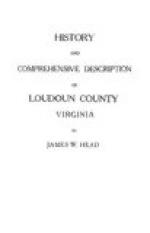“They burned all the mills and factories, as well as hay, wheat, corn, straw, and every description of forage. Barns and stables, whether full or empty, were burned.
“At Mrs. Fletcher’s (a widow), where the hogs had been killed for her winter’s supply of meat, the soldiers made a pile of rails upon which the hogs were placed and burned. They even went to the Poor House and burned and destroyed the supplies provided for the helpless and dependent paupers. On various previous occasions, however, the Alms House had been visited by raiding parties, so that at this time there was but little left, but of that little the larger portion was taken.
[Footnote 39: Mosby’s Rangers, by James J. Williamson.]
“Colonel Mosby did not call the command together, therefore there was no organized resistance, but Rangers managed to save a great deal of live stock for the farmers by driving it off to places of safety.”
Home Life During the War.
In Loudoun, as everywhere in every age, the seriousness of war was not fully realized until the volunteer soldiery, following a short season of feverish social gayety, interspersed with dress parades and exhibition drills, had departed for their respective posts. Immediately and with one accord those left behind settled themselves to watch and wait and work and pray for the absent ones and the cause they had so readily championed.
When few slaves were owned by a family the white boys, too young for service in the army, worked with them in the fields, while the girls busied themselves with household duties, though, at times, they, too, labored in the open. In families owning no slaves the old men, cripples, women, and children were forced to shoulder the arduous labors of the farm.
Stern necessity had leveled sexual and worldly distinctions, and manual labor was, at times, performed by all who were in the least physically fitted for it. All classes early became inured to makeshifts and privations, though they managed in some unselfish manner to send, from time to time, great quantities of clothing, meats, and other supplies to the soldiers in the field and their wounded comrades in the army hospitals.
The intense devotion of Loudoun women to the Confederate cause was most irritating to a certain class of Federal officers in the armies that invaded Northern Virginia. They seemed to think that through their military prowess they had conquered entrance into Southern society, but the women repulsed them at every turn and quite effectually checked their presumptuous advances.
The women of all classes played and sang Confederate airs on every occasion, and, though ordered by the military authorities to desist, with consummate daring they usually persisted until a guard of soldiers had been detailed to enforce the order. The Federal officers who acted in a gentlemanly manner toward the non-combatants were accused by their rude fellows and by ruder newspaper correspondents of being “wound round the fingers of the rebel women,” who, they were sure, had some cherished object in view.




